Sociology Report: Multiculturalism in the Canadian Service Sector
VerifiedAdded on 2022/08/13
|12
|2738
|20
Report
AI Summary
This report examines the impact of multiculturalism on the Canadian service sector, focusing on the slowdown of the industry and the potential benefits of integrating a diverse workforce. It explores the historical context of immigration in Canada, the adoption of multiculturalism as a federal policy, and the challenges of discrimination against immigrants and minorities. The report uses a critical theory framework to analyze the interplay of multiculturalism, the immigrant workforce, and discrimination within the Canadian service industry. It discusses the structure of the Canadian service sector, its importance to the economy, and the decline in job creation since 2017. The report highlights the importance of professional knowledge and specialization within the service industry and how the skilled immigrant workforce can contribute to its revival. It also addresses the need to mitigate discriminatory practices in hiring and recruitment to fully leverage the potential of a multicultural workforce. The report concludes with recommendations for incorporating multiculturalism effectively in the service industry and maximizing the benefits of a diverse workforce.
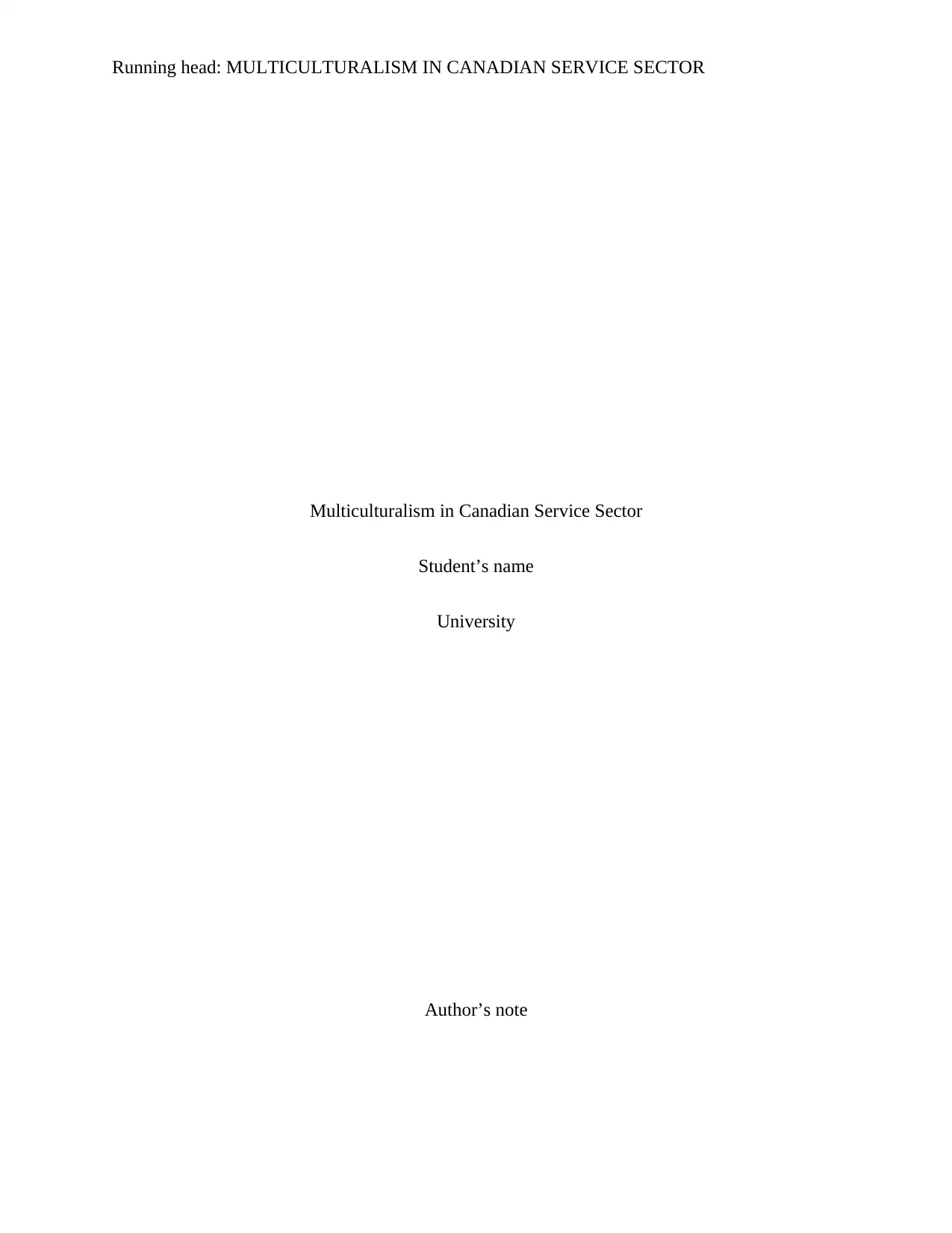
Running head: MULTICULTURALISM IN CANADIAN SERVICE SECTOR
Multiculturalism in Canadian Service Sector
Student’s name
University
Author’s note
Multiculturalism in Canadian Service Sector
Student’s name
University
Author’s note
Paraphrase This Document
Need a fresh take? Get an instant paraphrase of this document with our AI Paraphraser
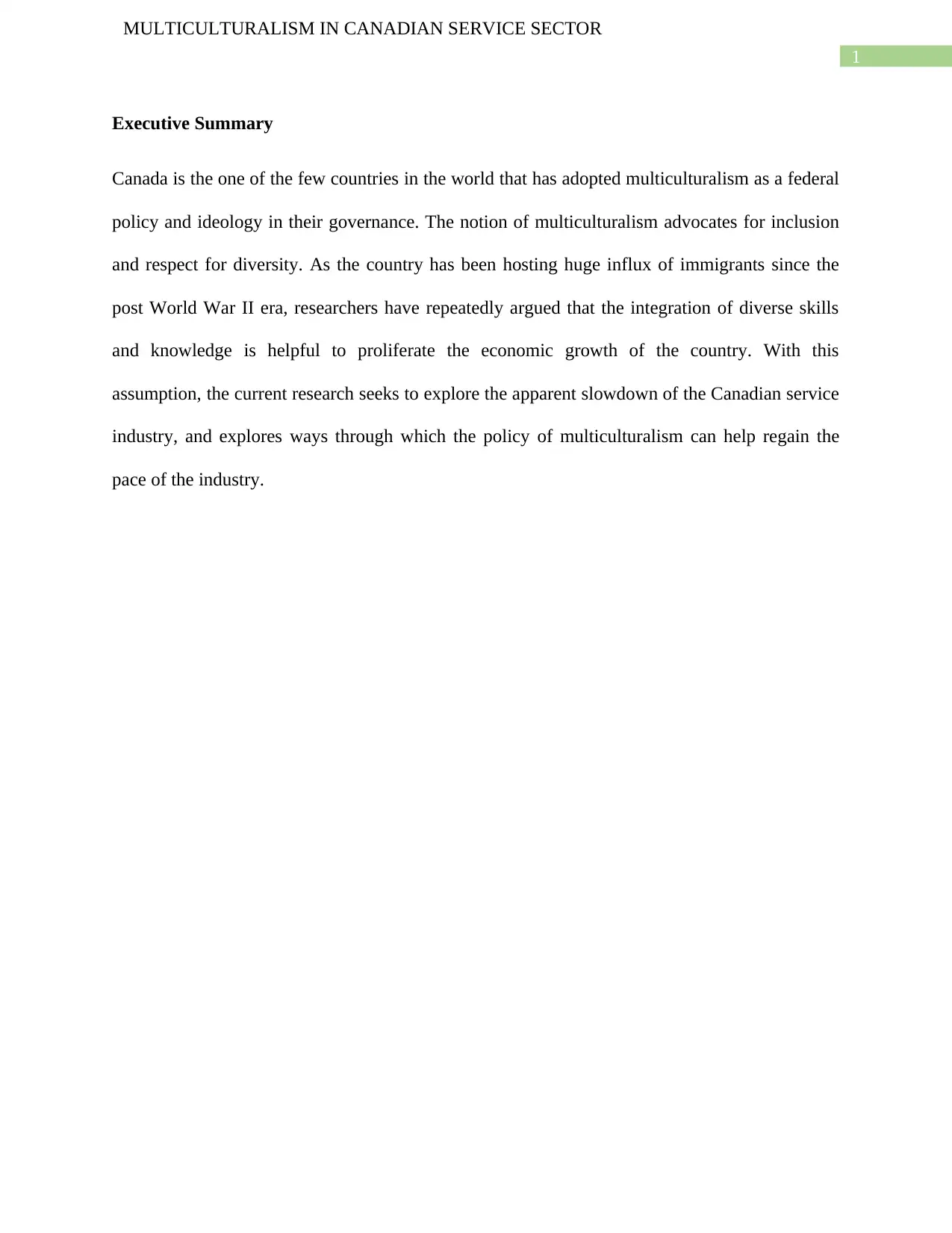
1
MULTICULTURALISM IN CANADIAN SERVICE SECTOR
Executive Summary
Canada is the one of the few countries in the world that has adopted multiculturalism as a federal
policy and ideology in their governance. The notion of multiculturalism advocates for inclusion
and respect for diversity. As the country has been hosting huge influx of immigrants since the
post World War II era, researchers have repeatedly argued that the integration of diverse skills
and knowledge is helpful to proliferate the economic growth of the country. With this
assumption, the current research seeks to explore the apparent slowdown of the Canadian service
industry, and explores ways through which the policy of multiculturalism can help regain the
pace of the industry.
MULTICULTURALISM IN CANADIAN SERVICE SECTOR
Executive Summary
Canada is the one of the few countries in the world that has adopted multiculturalism as a federal
policy and ideology in their governance. The notion of multiculturalism advocates for inclusion
and respect for diversity. As the country has been hosting huge influx of immigrants since the
post World War II era, researchers have repeatedly argued that the integration of diverse skills
and knowledge is helpful to proliferate the economic growth of the country. With this
assumption, the current research seeks to explore the apparent slowdown of the Canadian service
industry, and explores ways through which the policy of multiculturalism can help regain the
pace of the industry.
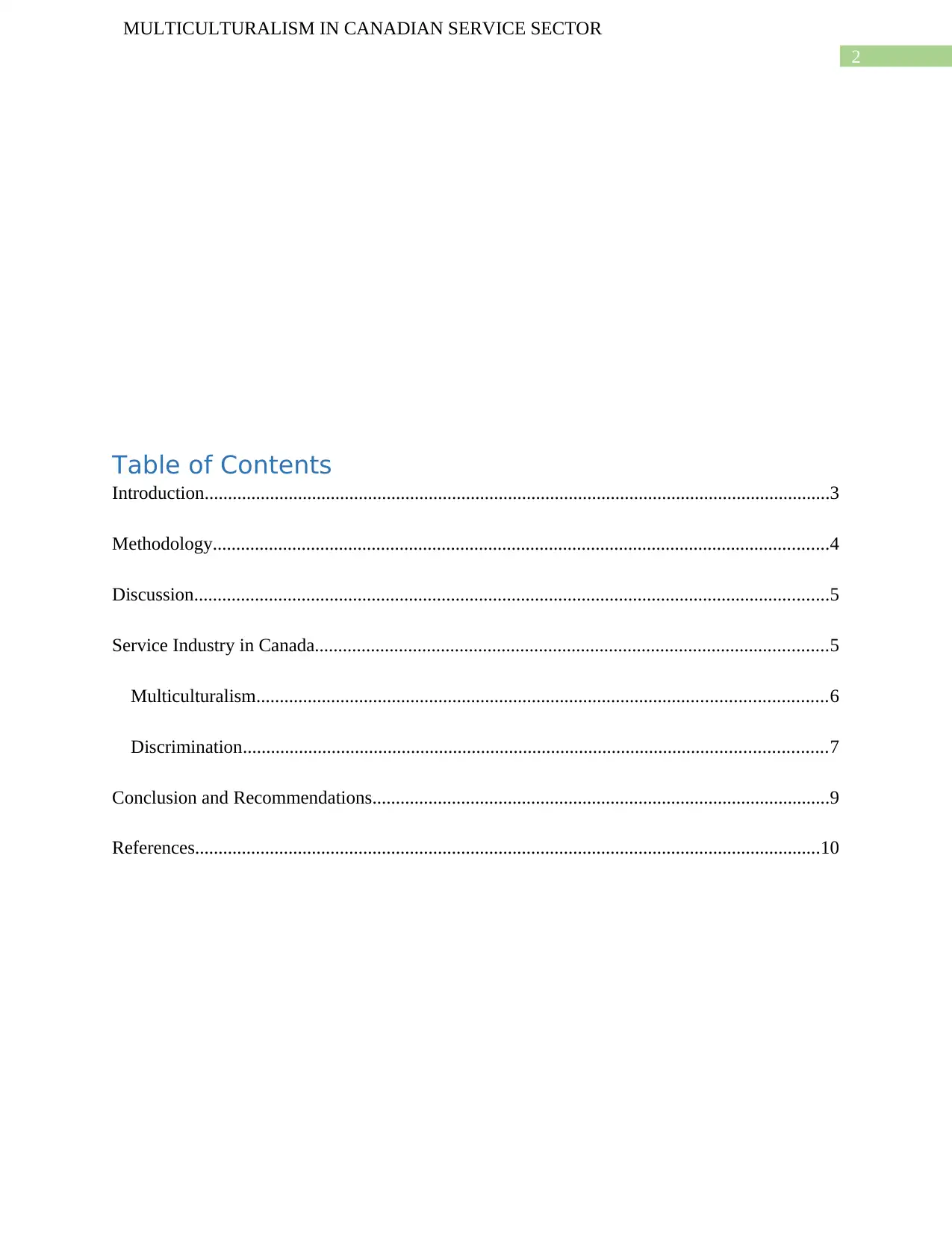
2
MULTICULTURALISM IN CANADIAN SERVICE SECTOR
Table of Contents
Introduction......................................................................................................................................3
Methodology....................................................................................................................................4
Discussion........................................................................................................................................5
Service Industry in Canada..............................................................................................................5
Multiculturalism..........................................................................................................................6
Discrimination.............................................................................................................................7
Conclusion and Recommendations..................................................................................................9
References......................................................................................................................................10
MULTICULTURALISM IN CANADIAN SERVICE SECTOR
Table of Contents
Introduction......................................................................................................................................3
Methodology....................................................................................................................................4
Discussion........................................................................................................................................5
Service Industry in Canada..............................................................................................................5
Multiculturalism..........................................................................................................................6
Discrimination.............................................................................................................................7
Conclusion and Recommendations..................................................................................................9
References......................................................................................................................................10
⊘ This is a preview!⊘
Do you want full access?
Subscribe today to unlock all pages.

Trusted by 1+ million students worldwide
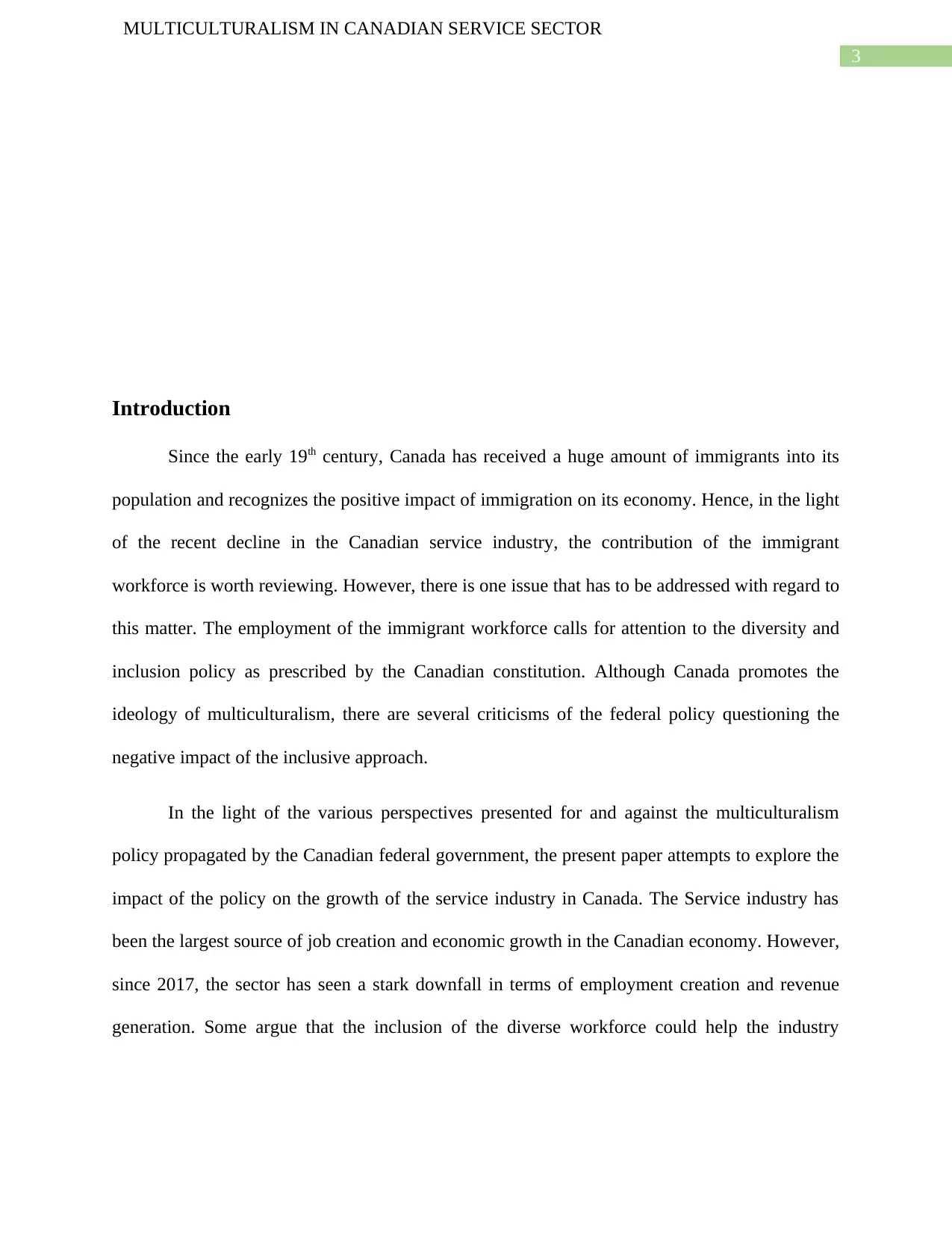
3
MULTICULTURALISM IN CANADIAN SERVICE SECTOR
Introduction
Since the early 19th century, Canada has received a huge amount of immigrants into its
population and recognizes the positive impact of immigration on its economy. Hence, in the light
of the recent decline in the Canadian service industry, the contribution of the immigrant
workforce is worth reviewing. However, there is one issue that has to be addressed with regard to
this matter. The employment of the immigrant workforce calls for attention to the diversity and
inclusion policy as prescribed by the Canadian constitution. Although Canada promotes the
ideology of multiculturalism, there are several criticisms of the federal policy questioning the
negative impact of the inclusive approach.
In the light of the various perspectives presented for and against the multiculturalism
policy propagated by the Canadian federal government, the present paper attempts to explore the
impact of the policy on the growth of the service industry in Canada. The Service industry has
been the largest source of job creation and economic growth in the Canadian economy. However,
since 2017, the sector has seen a stark downfall in terms of employment creation and revenue
generation. Some argue that the inclusion of the diverse workforce could help the industry
MULTICULTURALISM IN CANADIAN SERVICE SECTOR
Introduction
Since the early 19th century, Canada has received a huge amount of immigrants into its
population and recognizes the positive impact of immigration on its economy. Hence, in the light
of the recent decline in the Canadian service industry, the contribution of the immigrant
workforce is worth reviewing. However, there is one issue that has to be addressed with regard to
this matter. The employment of the immigrant workforce calls for attention to the diversity and
inclusion policy as prescribed by the Canadian constitution. Although Canada promotes the
ideology of multiculturalism, there are several criticisms of the federal policy questioning the
negative impact of the inclusive approach.
In the light of the various perspectives presented for and against the multiculturalism
policy propagated by the Canadian federal government, the present paper attempts to explore the
impact of the policy on the growth of the service industry in Canada. The Service industry has
been the largest source of job creation and economic growth in the Canadian economy. However,
since 2017, the sector has seen a stark downfall in terms of employment creation and revenue
generation. Some argue that the inclusion of the diverse workforce could help the industry
Paraphrase This Document
Need a fresh take? Get an instant paraphrase of this document with our AI Paraphraser
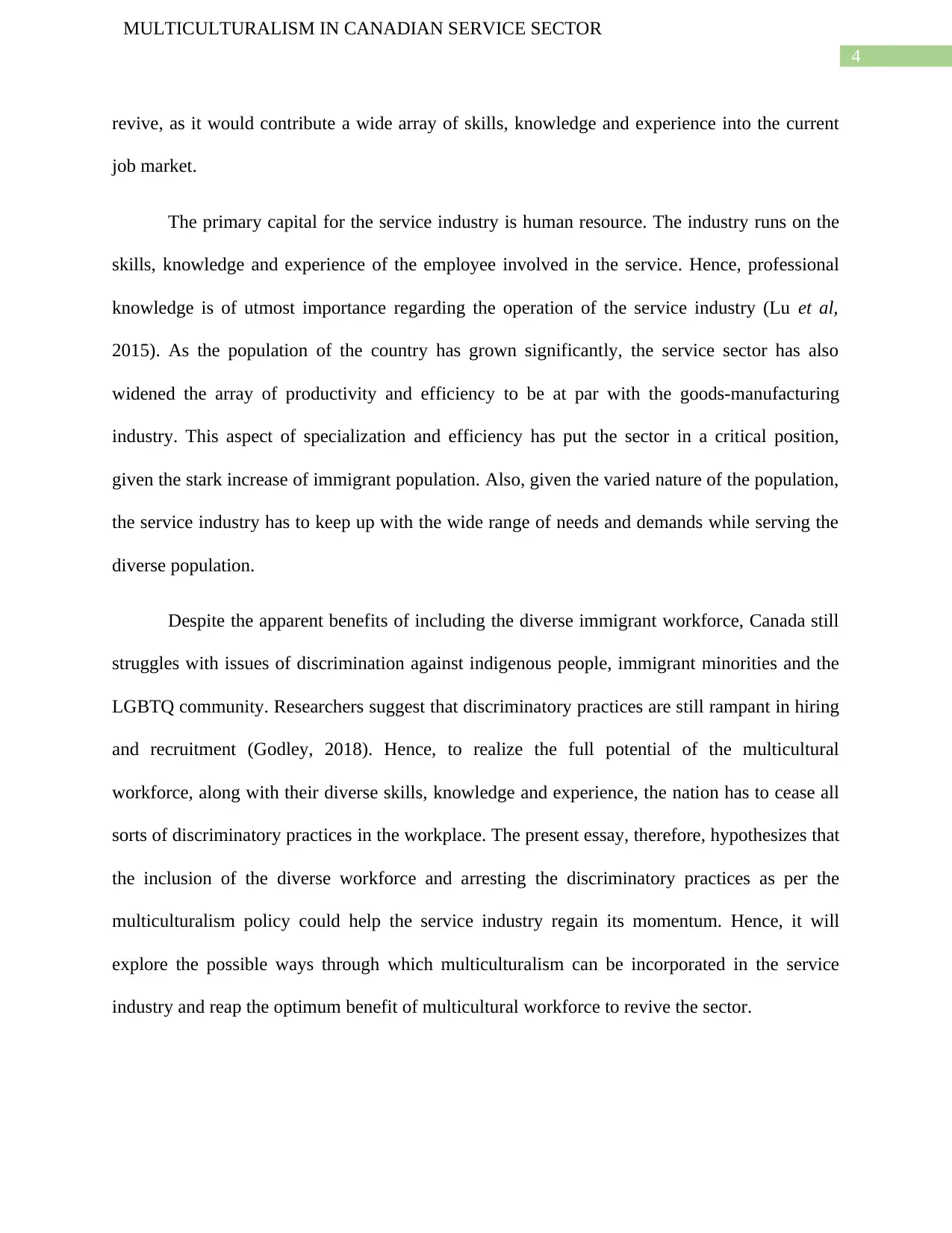
4
MULTICULTURALISM IN CANADIAN SERVICE SECTOR
revive, as it would contribute a wide array of skills, knowledge and experience into the current
job market.
The primary capital for the service industry is human resource. The industry runs on the
skills, knowledge and experience of the employee involved in the service. Hence, professional
knowledge is of utmost importance regarding the operation of the service industry (Lu et al,
2015). As the population of the country has grown significantly, the service sector has also
widened the array of productivity and efficiency to be at par with the goods-manufacturing
industry. This aspect of specialization and efficiency has put the sector in a critical position,
given the stark increase of immigrant population. Also, given the varied nature of the population,
the service industry has to keep up with the wide range of needs and demands while serving the
diverse population.
Despite the apparent benefits of including the diverse immigrant workforce, Canada still
struggles with issues of discrimination against indigenous people, immigrant minorities and the
LGBTQ community. Researchers suggest that discriminatory practices are still rampant in hiring
and recruitment (Godley, 2018). Hence, to realize the full potential of the multicultural
workforce, along with their diverse skills, knowledge and experience, the nation has to cease all
sorts of discriminatory practices in the workplace. The present essay, therefore, hypothesizes that
the inclusion of the diverse workforce and arresting the discriminatory practices as per the
multiculturalism policy could help the service industry regain its momentum. Hence, it will
explore the possible ways through which multiculturalism can be incorporated in the service
industry and reap the optimum benefit of multicultural workforce to revive the sector.
MULTICULTURALISM IN CANADIAN SERVICE SECTOR
revive, as it would contribute a wide array of skills, knowledge and experience into the current
job market.
The primary capital for the service industry is human resource. The industry runs on the
skills, knowledge and experience of the employee involved in the service. Hence, professional
knowledge is of utmost importance regarding the operation of the service industry (Lu et al,
2015). As the population of the country has grown significantly, the service sector has also
widened the array of productivity and efficiency to be at par with the goods-manufacturing
industry. This aspect of specialization and efficiency has put the sector in a critical position,
given the stark increase of immigrant population. Also, given the varied nature of the population,
the service industry has to keep up with the wide range of needs and demands while serving the
diverse population.
Despite the apparent benefits of including the diverse immigrant workforce, Canada still
struggles with issues of discrimination against indigenous people, immigrant minorities and the
LGBTQ community. Researchers suggest that discriminatory practices are still rampant in hiring
and recruitment (Godley, 2018). Hence, to realize the full potential of the multicultural
workforce, along with their diverse skills, knowledge and experience, the nation has to cease all
sorts of discriminatory practices in the workplace. The present essay, therefore, hypothesizes that
the inclusion of the diverse workforce and arresting the discriminatory practices as per the
multiculturalism policy could help the service industry regain its momentum. Hence, it will
explore the possible ways through which multiculturalism can be incorporated in the service
industry and reap the optimum benefit of multicultural workforce to revive the sector.
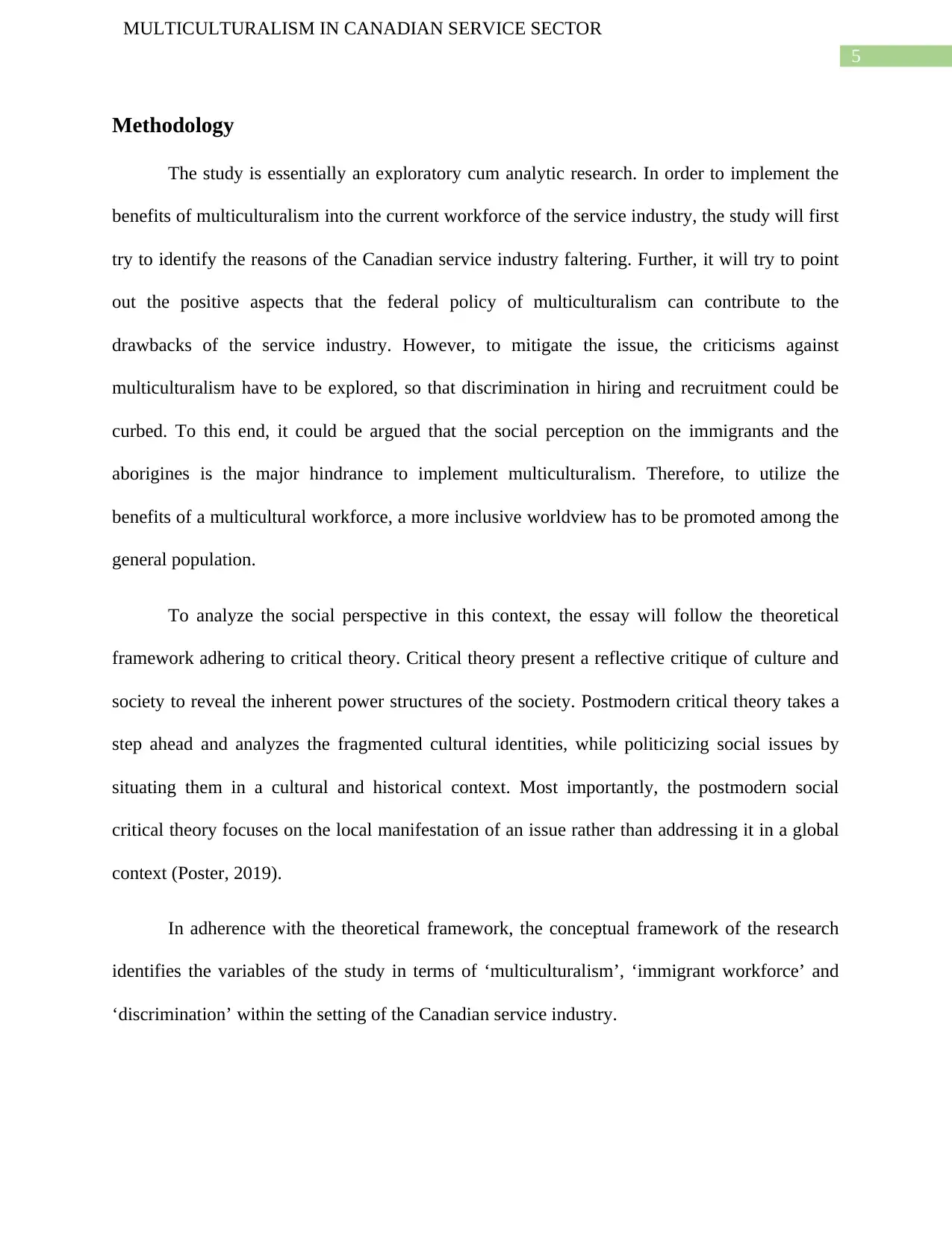
5
MULTICULTURALISM IN CANADIAN SERVICE SECTOR
Methodology
The study is essentially an exploratory cum analytic research. In order to implement the
benefits of multiculturalism into the current workforce of the service industry, the study will first
try to identify the reasons of the Canadian service industry faltering. Further, it will try to point
out the positive aspects that the federal policy of multiculturalism can contribute to the
drawbacks of the service industry. However, to mitigate the issue, the criticisms against
multiculturalism have to be explored, so that discrimination in hiring and recruitment could be
curbed. To this end, it could be argued that the social perception on the immigrants and the
aborigines is the major hindrance to implement multiculturalism. Therefore, to utilize the
benefits of a multicultural workforce, a more inclusive worldview has to be promoted among the
general population.
To analyze the social perspective in this context, the essay will follow the theoretical
framework adhering to critical theory. Critical theory present a reflective critique of culture and
society to reveal the inherent power structures of the society. Postmodern critical theory takes a
step ahead and analyzes the fragmented cultural identities, while politicizing social issues by
situating them in a cultural and historical context. Most importantly, the postmodern social
critical theory focuses on the local manifestation of an issue rather than addressing it in a global
context (Poster, 2019).
In adherence with the theoretical framework, the conceptual framework of the research
identifies the variables of the study in terms of ‘multiculturalism’, ‘immigrant workforce’ and
‘discrimination’ within the setting of the Canadian service industry.
MULTICULTURALISM IN CANADIAN SERVICE SECTOR
Methodology
The study is essentially an exploratory cum analytic research. In order to implement the
benefits of multiculturalism into the current workforce of the service industry, the study will first
try to identify the reasons of the Canadian service industry faltering. Further, it will try to point
out the positive aspects that the federal policy of multiculturalism can contribute to the
drawbacks of the service industry. However, to mitigate the issue, the criticisms against
multiculturalism have to be explored, so that discrimination in hiring and recruitment could be
curbed. To this end, it could be argued that the social perception on the immigrants and the
aborigines is the major hindrance to implement multiculturalism. Therefore, to utilize the
benefits of a multicultural workforce, a more inclusive worldview has to be promoted among the
general population.
To analyze the social perspective in this context, the essay will follow the theoretical
framework adhering to critical theory. Critical theory present a reflective critique of culture and
society to reveal the inherent power structures of the society. Postmodern critical theory takes a
step ahead and analyzes the fragmented cultural identities, while politicizing social issues by
situating them in a cultural and historical context. Most importantly, the postmodern social
critical theory focuses on the local manifestation of an issue rather than addressing it in a global
context (Poster, 2019).
In adherence with the theoretical framework, the conceptual framework of the research
identifies the variables of the study in terms of ‘multiculturalism’, ‘immigrant workforce’ and
‘discrimination’ within the setting of the Canadian service industry.
⊘ This is a preview!⊘
Do you want full access?
Subscribe today to unlock all pages.

Trusted by 1+ million students worldwide
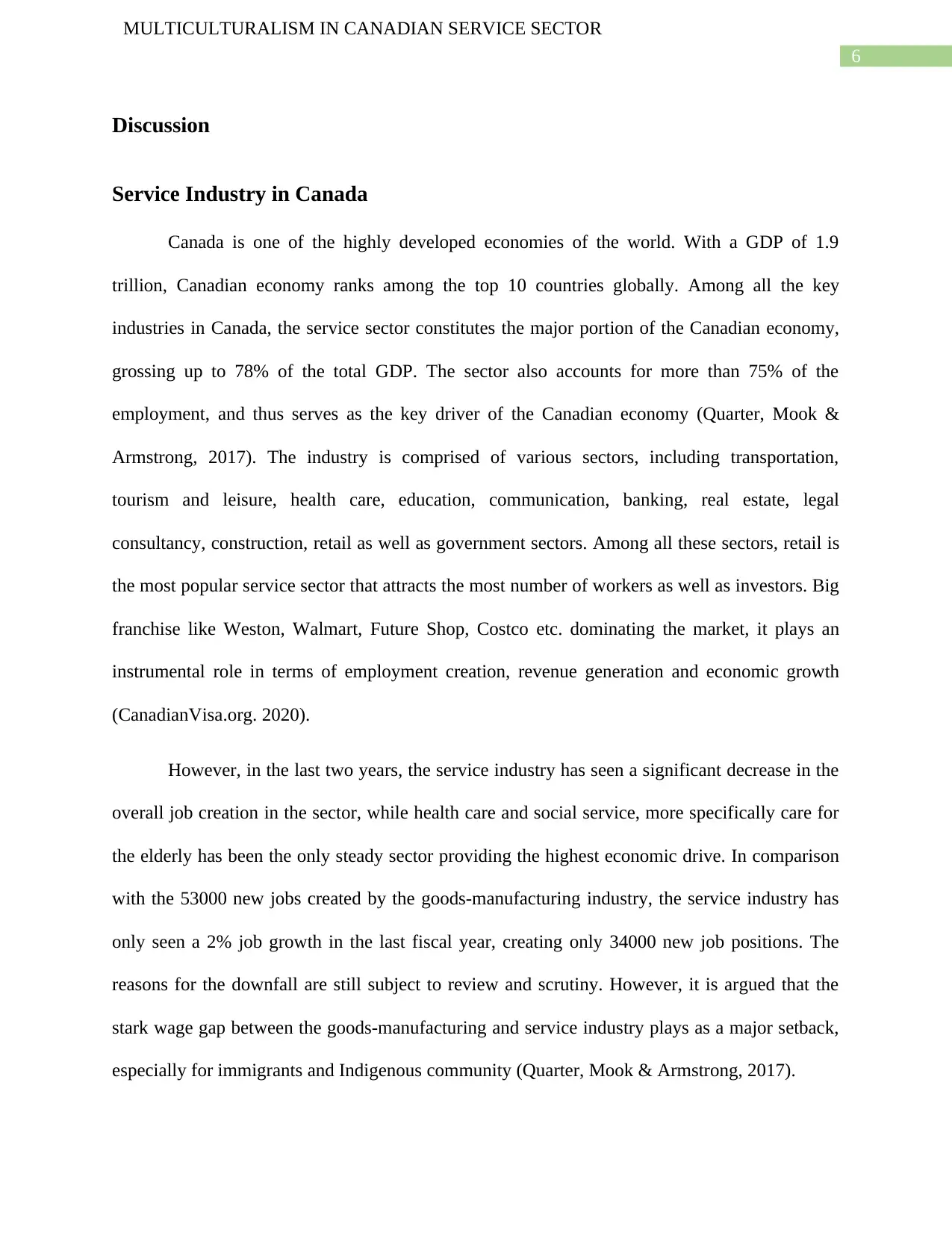
6
MULTICULTURALISM IN CANADIAN SERVICE SECTOR
Discussion
Service Industry in Canada
Canada is one of the highly developed economies of the world. With a GDP of 1.9
trillion, Canadian economy ranks among the top 10 countries globally. Among all the key
industries in Canada, the service sector constitutes the major portion of the Canadian economy,
grossing up to 78% of the total GDP. The sector also accounts for more than 75% of the
employment, and thus serves as the key driver of the Canadian economy (Quarter, Mook &
Armstrong, 2017). The industry is comprised of various sectors, including transportation,
tourism and leisure, health care, education, communication, banking, real estate, legal
consultancy, construction, retail as well as government sectors. Among all these sectors, retail is
the most popular service sector that attracts the most number of workers as well as investors. Big
franchise like Weston, Walmart, Future Shop, Costco etc. dominating the market, it plays an
instrumental role in terms of employment creation, revenue generation and economic growth
(CanadianVisa.org. 2020).
However, in the last two years, the service industry has seen a significant decrease in the
overall job creation in the sector, while health care and social service, more specifically care for
the elderly has been the only steady sector providing the highest economic drive. In comparison
with the 53000 new jobs created by the goods-manufacturing industry, the service industry has
only seen a 2% job growth in the last fiscal year, creating only 34000 new job positions. The
reasons for the downfall are still subject to review and scrutiny. However, it is argued that the
stark wage gap between the goods-manufacturing and service industry plays as a major setback,
especially for immigrants and Indigenous community (Quarter, Mook & Armstrong, 2017).
MULTICULTURALISM IN CANADIAN SERVICE SECTOR
Discussion
Service Industry in Canada
Canada is one of the highly developed economies of the world. With a GDP of 1.9
trillion, Canadian economy ranks among the top 10 countries globally. Among all the key
industries in Canada, the service sector constitutes the major portion of the Canadian economy,
grossing up to 78% of the total GDP. The sector also accounts for more than 75% of the
employment, and thus serves as the key driver of the Canadian economy (Quarter, Mook &
Armstrong, 2017). The industry is comprised of various sectors, including transportation,
tourism and leisure, health care, education, communication, banking, real estate, legal
consultancy, construction, retail as well as government sectors. Among all these sectors, retail is
the most popular service sector that attracts the most number of workers as well as investors. Big
franchise like Weston, Walmart, Future Shop, Costco etc. dominating the market, it plays an
instrumental role in terms of employment creation, revenue generation and economic growth
(CanadianVisa.org. 2020).
However, in the last two years, the service industry has seen a significant decrease in the
overall job creation in the sector, while health care and social service, more specifically care for
the elderly has been the only steady sector providing the highest economic drive. In comparison
with the 53000 new jobs created by the goods-manufacturing industry, the service industry has
only seen a 2% job growth in the last fiscal year, creating only 34000 new job positions. The
reasons for the downfall are still subject to review and scrutiny. However, it is argued that the
stark wage gap between the goods-manufacturing and service industry plays as a major setback,
especially for immigrants and Indigenous community (Quarter, Mook & Armstrong, 2017).
Paraphrase This Document
Need a fresh take? Get an instant paraphrase of this document with our AI Paraphraser
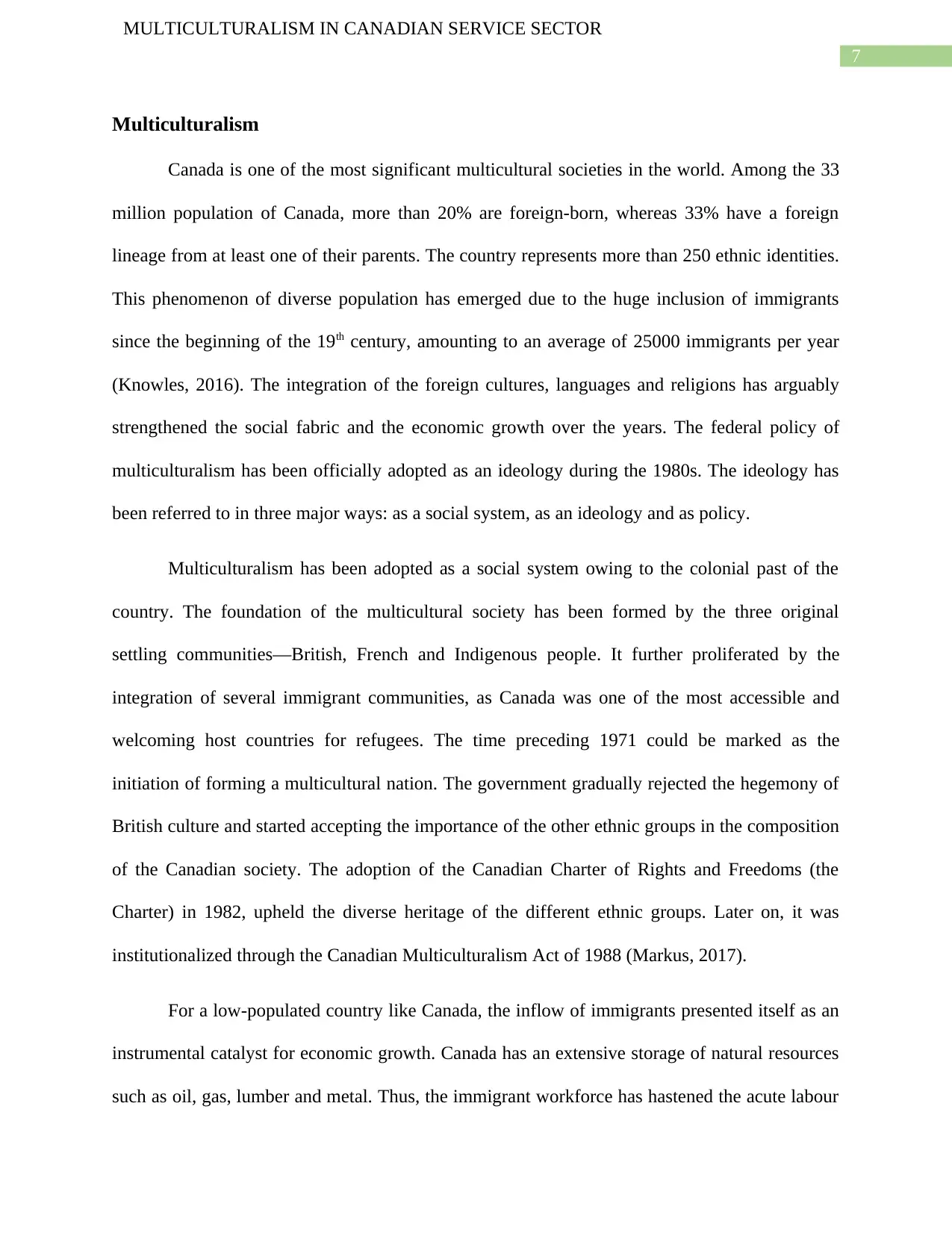
7
MULTICULTURALISM IN CANADIAN SERVICE SECTOR
Multiculturalism
Canada is one of the most significant multicultural societies in the world. Among the 33
million population of Canada, more than 20% are foreign-born, whereas 33% have a foreign
lineage from at least one of their parents. The country represents more than 250 ethnic identities.
This phenomenon of diverse population has emerged due to the huge inclusion of immigrants
since the beginning of the 19th century, amounting to an average of 25000 immigrants per year
(Knowles, 2016). The integration of the foreign cultures, languages and religions has arguably
strengthened the social fabric and the economic growth over the years. The federal policy of
multiculturalism has been officially adopted as an ideology during the 1980s. The ideology has
been referred to in three major ways: as a social system, as an ideology and as policy.
Multiculturalism has been adopted as a social system owing to the colonial past of the
country. The foundation of the multicultural society has been formed by the three original
settling communities—British, French and Indigenous people. It further proliferated by the
integration of several immigrant communities, as Canada was one of the most accessible and
welcoming host countries for refugees. The time preceding 1971 could be marked as the
initiation of forming a multicultural nation. The government gradually rejected the hegemony of
British culture and started accepting the importance of the other ethnic groups in the composition
of the Canadian society. The adoption of the Canadian Charter of Rights and Freedoms (the
Charter) in 1982, upheld the diverse heritage of the different ethnic groups. Later on, it was
institutionalized through the Canadian Multiculturalism Act of 1988 (Markus, 2017).
For a low-populated country like Canada, the inflow of immigrants presented itself as an
instrumental catalyst for economic growth. Canada has an extensive storage of natural resources
such as oil, gas, lumber and metal. Thus, the immigrant workforce has hastened the acute labour
MULTICULTURALISM IN CANADIAN SERVICE SECTOR
Multiculturalism
Canada is one of the most significant multicultural societies in the world. Among the 33
million population of Canada, more than 20% are foreign-born, whereas 33% have a foreign
lineage from at least one of their parents. The country represents more than 250 ethnic identities.
This phenomenon of diverse population has emerged due to the huge inclusion of immigrants
since the beginning of the 19th century, amounting to an average of 25000 immigrants per year
(Knowles, 2016). The integration of the foreign cultures, languages and religions has arguably
strengthened the social fabric and the economic growth over the years. The federal policy of
multiculturalism has been officially adopted as an ideology during the 1980s. The ideology has
been referred to in three major ways: as a social system, as an ideology and as policy.
Multiculturalism has been adopted as a social system owing to the colonial past of the
country. The foundation of the multicultural society has been formed by the three original
settling communities—British, French and Indigenous people. It further proliferated by the
integration of several immigrant communities, as Canada was one of the most accessible and
welcoming host countries for refugees. The time preceding 1971 could be marked as the
initiation of forming a multicultural nation. The government gradually rejected the hegemony of
British culture and started accepting the importance of the other ethnic groups in the composition
of the Canadian society. The adoption of the Canadian Charter of Rights and Freedoms (the
Charter) in 1982, upheld the diverse heritage of the different ethnic groups. Later on, it was
institutionalized through the Canadian Multiculturalism Act of 1988 (Markus, 2017).
For a low-populated country like Canada, the inflow of immigrants presented itself as an
instrumental catalyst for economic growth. Canada has an extensive storage of natural resources
such as oil, gas, lumber and metal. Thus, the immigrant workforce has hastened the acute labour
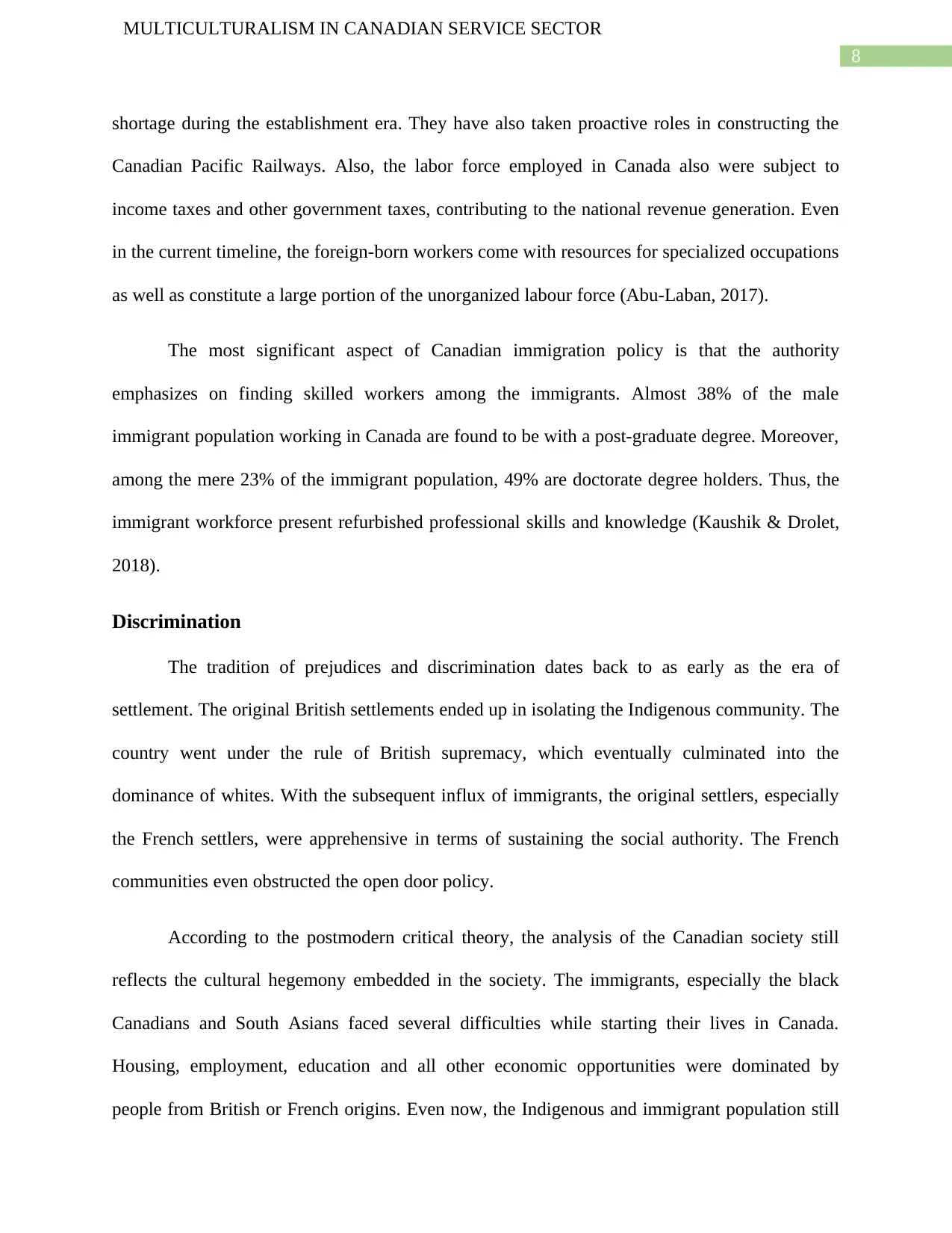
8
MULTICULTURALISM IN CANADIAN SERVICE SECTOR
shortage during the establishment era. They have also taken proactive roles in constructing the
Canadian Pacific Railways. Also, the labor force employed in Canada also were subject to
income taxes and other government taxes, contributing to the national revenue generation. Even
in the current timeline, the foreign-born workers come with resources for specialized occupations
as well as constitute a large portion of the unorganized labour force (Abu-Laban, 2017).
The most significant aspect of Canadian immigration policy is that the authority
emphasizes on finding skilled workers among the immigrants. Almost 38% of the male
immigrant population working in Canada are found to be with a post-graduate degree. Moreover,
among the mere 23% of the immigrant population, 49% are doctorate degree holders. Thus, the
immigrant workforce present refurbished professional skills and knowledge (Kaushik & Drolet,
2018).
Discrimination
The tradition of prejudices and discrimination dates back to as early as the era of
settlement. The original British settlements ended up in isolating the Indigenous community. The
country went under the rule of British supremacy, which eventually culminated into the
dominance of whites. With the subsequent influx of immigrants, the original settlers, especially
the French settlers, were apprehensive in terms of sustaining the social authority. The French
communities even obstructed the open door policy.
According to the postmodern critical theory, the analysis of the Canadian society still
reflects the cultural hegemony embedded in the society. The immigrants, especially the black
Canadians and South Asians faced several difficulties while starting their lives in Canada.
Housing, employment, education and all other economic opportunities were dominated by
people from British or French origins. Even now, the Indigenous and immigrant population still
MULTICULTURALISM IN CANADIAN SERVICE SECTOR
shortage during the establishment era. They have also taken proactive roles in constructing the
Canadian Pacific Railways. Also, the labor force employed in Canada also were subject to
income taxes and other government taxes, contributing to the national revenue generation. Even
in the current timeline, the foreign-born workers come with resources for specialized occupations
as well as constitute a large portion of the unorganized labour force (Abu-Laban, 2017).
The most significant aspect of Canadian immigration policy is that the authority
emphasizes on finding skilled workers among the immigrants. Almost 38% of the male
immigrant population working in Canada are found to be with a post-graduate degree. Moreover,
among the mere 23% of the immigrant population, 49% are doctorate degree holders. Thus, the
immigrant workforce present refurbished professional skills and knowledge (Kaushik & Drolet,
2018).
Discrimination
The tradition of prejudices and discrimination dates back to as early as the era of
settlement. The original British settlements ended up in isolating the Indigenous community. The
country went under the rule of British supremacy, which eventually culminated into the
dominance of whites. With the subsequent influx of immigrants, the original settlers, especially
the French settlers, were apprehensive in terms of sustaining the social authority. The French
communities even obstructed the open door policy.
According to the postmodern critical theory, the analysis of the Canadian society still
reflects the cultural hegemony embedded in the society. The immigrants, especially the black
Canadians and South Asians faced several difficulties while starting their lives in Canada.
Housing, employment, education and all other economic opportunities were dominated by
people from British or French origins. Even now, the Indigenous and immigrant population still
⊘ This is a preview!⊘
Do you want full access?
Subscribe today to unlock all pages.

Trusted by 1+ million students worldwide
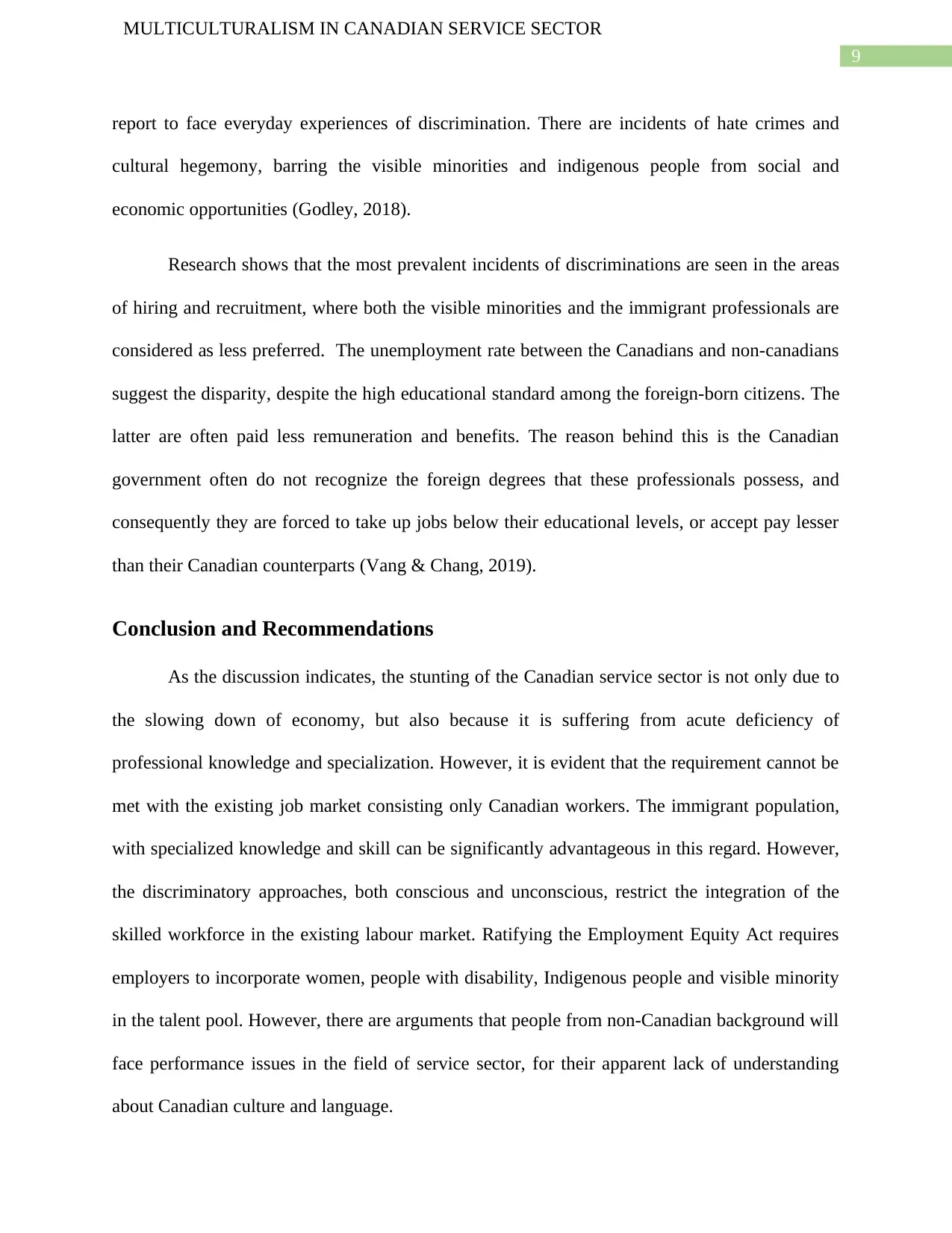
9
MULTICULTURALISM IN CANADIAN SERVICE SECTOR
report to face everyday experiences of discrimination. There are incidents of hate crimes and
cultural hegemony, barring the visible minorities and indigenous people from social and
economic opportunities (Godley, 2018).
Research shows that the most prevalent incidents of discriminations are seen in the areas
of hiring and recruitment, where both the visible minorities and the immigrant professionals are
considered as less preferred. The unemployment rate between the Canadians and non-canadians
suggest the disparity, despite the high educational standard among the foreign-born citizens. The
latter are often paid less remuneration and benefits. The reason behind this is the Canadian
government often do not recognize the foreign degrees that these professionals possess, and
consequently they are forced to take up jobs below their educational levels, or accept pay lesser
than their Canadian counterparts (Vang & Chang, 2019).
Conclusion and Recommendations
As the discussion indicates, the stunting of the Canadian service sector is not only due to
the slowing down of economy, but also because it is suffering from acute deficiency of
professional knowledge and specialization. However, it is evident that the requirement cannot be
met with the existing job market consisting only Canadian workers. The immigrant population,
with specialized knowledge and skill can be significantly advantageous in this regard. However,
the discriminatory approaches, both conscious and unconscious, restrict the integration of the
skilled workforce in the existing labour market. Ratifying the Employment Equity Act requires
employers to incorporate women, people with disability, Indigenous people and visible minority
in the talent pool. However, there are arguments that people from non-Canadian background will
face performance issues in the field of service sector, for their apparent lack of understanding
about Canadian culture and language.
MULTICULTURALISM IN CANADIAN SERVICE SECTOR
report to face everyday experiences of discrimination. There are incidents of hate crimes and
cultural hegemony, barring the visible minorities and indigenous people from social and
economic opportunities (Godley, 2018).
Research shows that the most prevalent incidents of discriminations are seen in the areas
of hiring and recruitment, where both the visible minorities and the immigrant professionals are
considered as less preferred. The unemployment rate between the Canadians and non-canadians
suggest the disparity, despite the high educational standard among the foreign-born citizens. The
latter are often paid less remuneration and benefits. The reason behind this is the Canadian
government often do not recognize the foreign degrees that these professionals possess, and
consequently they are forced to take up jobs below their educational levels, or accept pay lesser
than their Canadian counterparts (Vang & Chang, 2019).
Conclusion and Recommendations
As the discussion indicates, the stunting of the Canadian service sector is not only due to
the slowing down of economy, but also because it is suffering from acute deficiency of
professional knowledge and specialization. However, it is evident that the requirement cannot be
met with the existing job market consisting only Canadian workers. The immigrant population,
with specialized knowledge and skill can be significantly advantageous in this regard. However,
the discriminatory approaches, both conscious and unconscious, restrict the integration of the
skilled workforce in the existing labour market. Ratifying the Employment Equity Act requires
employers to incorporate women, people with disability, Indigenous people and visible minority
in the talent pool. However, there are arguments that people from non-Canadian background will
face performance issues in the field of service sector, for their apparent lack of understanding
about Canadian culture and language.
Paraphrase This Document
Need a fresh take? Get an instant paraphrase of this document with our AI Paraphraser
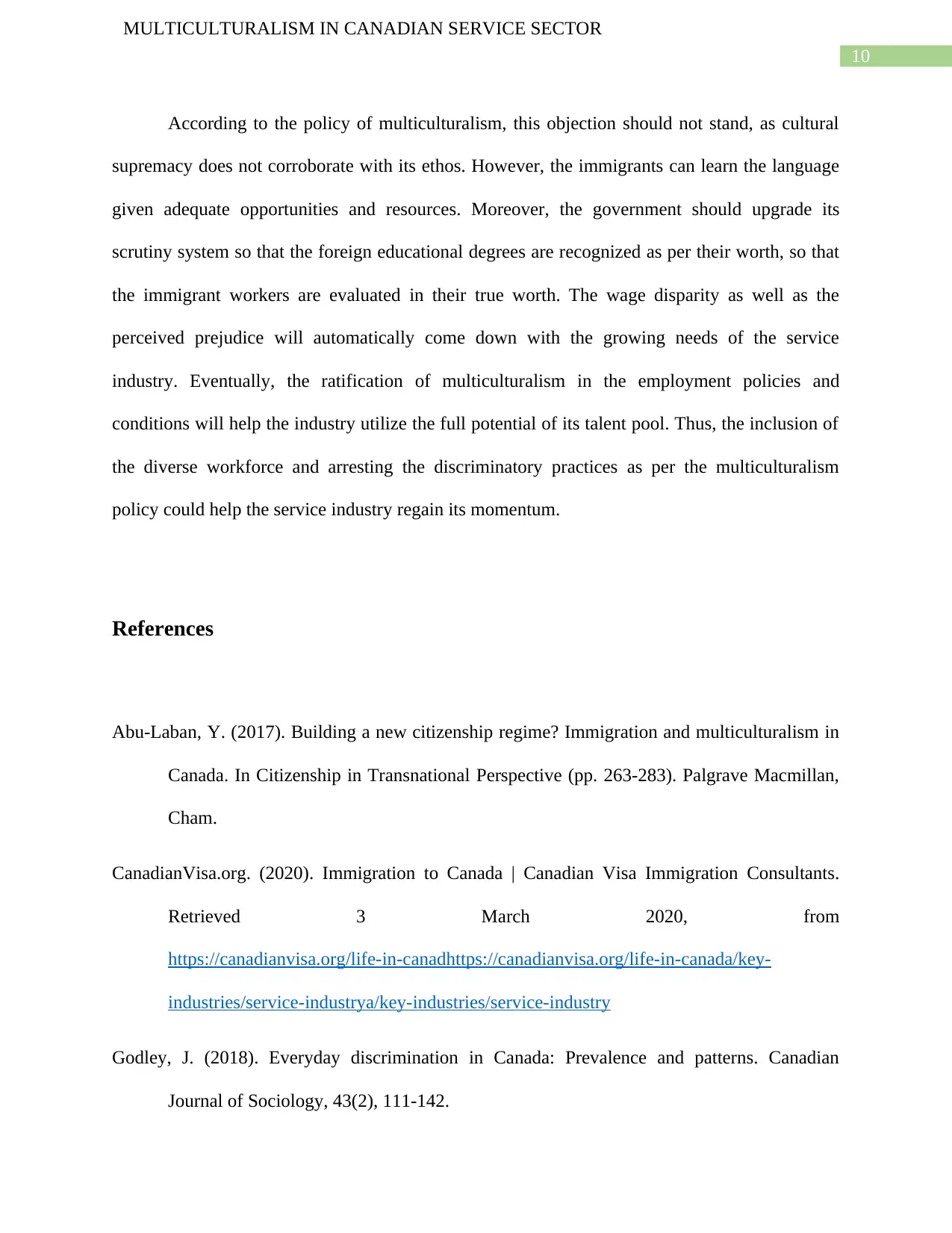
10
MULTICULTURALISM IN CANADIAN SERVICE SECTOR
According to the policy of multiculturalism, this objection should not stand, as cultural
supremacy does not corroborate with its ethos. However, the immigrants can learn the language
given adequate opportunities and resources. Moreover, the government should upgrade its
scrutiny system so that the foreign educational degrees are recognized as per their worth, so that
the immigrant workers are evaluated in their true worth. The wage disparity as well as the
perceived prejudice will automatically come down with the growing needs of the service
industry. Eventually, the ratification of multiculturalism in the employment policies and
conditions will help the industry utilize the full potential of its talent pool. Thus, the inclusion of
the diverse workforce and arresting the discriminatory practices as per the multiculturalism
policy could help the service industry regain its momentum.
References
Abu-Laban, Y. (2017). Building a new citizenship regime? Immigration and multiculturalism in
Canada. In Citizenship in Transnational Perspective (pp. 263-283). Palgrave Macmillan,
Cham.
CanadianVisa.org. (2020). Immigration to Canada | Canadian Visa Immigration Consultants.
Retrieved 3 March 2020, from
https://canadianvisa.org/life-in-canadhttps://canadianvisa.org/life-in-canada/key-
industries/service-industrya/key-industries/service-industry
Godley, J. (2018). Everyday discrimination in Canada: Prevalence and patterns. Canadian
Journal of Sociology, 43(2), 111-142.
MULTICULTURALISM IN CANADIAN SERVICE SECTOR
According to the policy of multiculturalism, this objection should not stand, as cultural
supremacy does not corroborate with its ethos. However, the immigrants can learn the language
given adequate opportunities and resources. Moreover, the government should upgrade its
scrutiny system so that the foreign educational degrees are recognized as per their worth, so that
the immigrant workers are evaluated in their true worth. The wage disparity as well as the
perceived prejudice will automatically come down with the growing needs of the service
industry. Eventually, the ratification of multiculturalism in the employment policies and
conditions will help the industry utilize the full potential of its talent pool. Thus, the inclusion of
the diverse workforce and arresting the discriminatory practices as per the multiculturalism
policy could help the service industry regain its momentum.
References
Abu-Laban, Y. (2017). Building a new citizenship regime? Immigration and multiculturalism in
Canada. In Citizenship in Transnational Perspective (pp. 263-283). Palgrave Macmillan,
Cham.
CanadianVisa.org. (2020). Immigration to Canada | Canadian Visa Immigration Consultants.
Retrieved 3 March 2020, from
https://canadianvisa.org/life-in-canadhttps://canadianvisa.org/life-in-canada/key-
industries/service-industrya/key-industries/service-industry
Godley, J. (2018). Everyday discrimination in Canada: Prevalence and patterns. Canadian
Journal of Sociology, 43(2), 111-142.
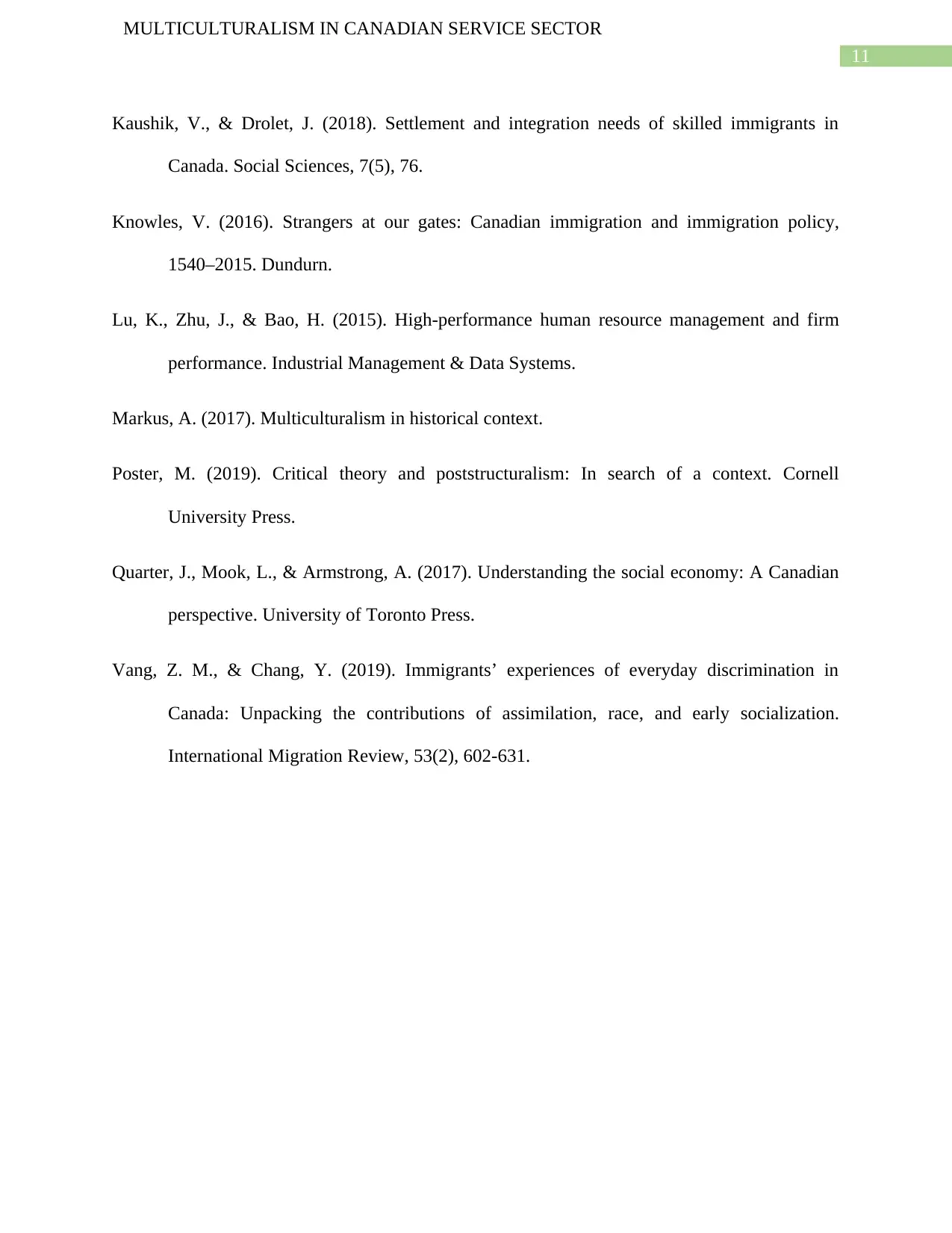
11
MULTICULTURALISM IN CANADIAN SERVICE SECTOR
Kaushik, V., & Drolet, J. (2018). Settlement and integration needs of skilled immigrants in
Canada. Social Sciences, 7(5), 76.
Knowles, V. (2016). Strangers at our gates: Canadian immigration and immigration policy,
1540–2015. Dundurn.
Lu, K., Zhu, J., & Bao, H. (2015). High-performance human resource management and firm
performance. Industrial Management & Data Systems.
Markus, A. (2017). Multiculturalism in historical context.
Poster, M. (2019). Critical theory and poststructuralism: In search of a context. Cornell
University Press.
Quarter, J., Mook, L., & Armstrong, A. (2017). Understanding the social economy: A Canadian
perspective. University of Toronto Press.
Vang, Z. M., & Chang, Y. (2019). Immigrants’ experiences of everyday discrimination in
Canada: Unpacking the contributions of assimilation, race, and early socialization.
International Migration Review, 53(2), 602-631.
MULTICULTURALISM IN CANADIAN SERVICE SECTOR
Kaushik, V., & Drolet, J. (2018). Settlement and integration needs of skilled immigrants in
Canada. Social Sciences, 7(5), 76.
Knowles, V. (2016). Strangers at our gates: Canadian immigration and immigration policy,
1540–2015. Dundurn.
Lu, K., Zhu, J., & Bao, H. (2015). High-performance human resource management and firm
performance. Industrial Management & Data Systems.
Markus, A. (2017). Multiculturalism in historical context.
Poster, M. (2019). Critical theory and poststructuralism: In search of a context. Cornell
University Press.
Quarter, J., Mook, L., & Armstrong, A. (2017). Understanding the social economy: A Canadian
perspective. University of Toronto Press.
Vang, Z. M., & Chang, Y. (2019). Immigrants’ experiences of everyday discrimination in
Canada: Unpacking the contributions of assimilation, race, and early socialization.
International Migration Review, 53(2), 602-631.
⊘ This is a preview!⊘
Do you want full access?
Subscribe today to unlock all pages.

Trusted by 1+ million students worldwide
1 out of 12
Related Documents
Your All-in-One AI-Powered Toolkit for Academic Success.
+13062052269
info@desklib.com
Available 24*7 on WhatsApp / Email
![[object Object]](/_next/static/media/star-bottom.7253800d.svg)
Unlock your academic potential
Copyright © 2020–2025 A2Z Services. All Rights Reserved. Developed and managed by ZUCOL.





